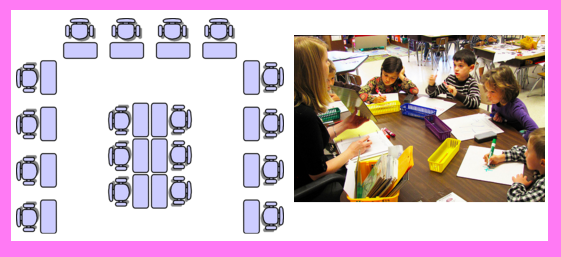


Classroom Management Strategies that Support Responsive Teaching
Managing Time:
- Use homework, personal agendas, etc to balance need for whole class and self-paced instruction
- Provide anchor activities (PBL project work) for students who finish early
- Move slowly with differentiation – tackle one remediation and one topic at a time
Controlling Noise:
- Provide and use signals for noise reduction
- Teach students to monitor noise levels as needed
- Use headsets or earplugs for students who need less distractions
Classroom Movement:
- Use task and room charts to help students locate where they should be for what they are doing
- Designate one student per team to gather materials
- Make seating area that faces away from active parts of classroom for students who need freedom from distractions
Flexible Use of Classroom Space:
- Experiment with ways to move furniture to create learning spaces
- Use center-in-a-box – partitions on the floor that serve as designated work areas
- Designate an independent working area for students who need extra practice or need to move ahead
Organizing & Distributing Resources:
- Design a table or area for storing and distributing key materials
- Use in-class folder filing system with student names, class periods, and team numbers
Monitoring Student Work:
- Use checklists of criteria to record competencies and trouble areas
- Record observations on sticky notes and store in a notebook that has at least 1 page dedicated per student. Review notes at least once per month
- Have students turn in work to designated physical and online locations
Make Time for Small Group Instruction:
- Let students know when you are off limits and why
- Establish experts who will answer questions while you are teaching small groups
- Use materials already available to you for small group activities
- Grade less daily work
- Go slowly but deliberately to differentiate
- Use guided practice, anchor tasks, personal agendas, centers, learning contracts, and other strategies and routines to help students work independently

Responsive teaching needs to be supported by classroom management routines that are both orderly and flexible. Research has shown that teachers who maintain orderly classroom environments are more likely to teach for meaning and understanding. PBL work can be complex and chaotic. Framing PBL work in terms of orderly routines and strategies can build student confidence.

Preparation Steps
- Investigate available classroom space. Brainstorm different furniture configurations that will create different learning spaces. Trial these spaces with students.
- Create diagrams that represent positively-tested furniture configurations
- Train students to move furniture between different configurations and the purpose of these configurations
- Set aside storage areas and turn-in areas (online, physical) for students to turn in work
- Survey students to see which noise reduction signals work best
- Create checklists that describe skills and common errors related to key concepts
- Pre-assess and assess students to determine who can serve as experts on select topics
- Gather resources for small group instructions
Early Implementation Steps
- Implement small group instruction that uses data to determine appropriate goals for specific learning groups
- Implement system (includes experts and resources) that allow students to work independently while teacher is focused on small group instruction
- Use formative and pre-assessments to let students know when they need to attend workshops and when they are workshop-exempt and can skip to project work
- Make connections between workshops and good project work explicit so students understand the relevance of workshop
- Grade less daily work – see Grading Smarter, Not Harder for ideas
Advanced Implementation Steps
- Use tools such as Aurasma to add another virtual learning layer on top of areas of the room
- Teach students how to use assessment data to set and track goals and plan related next steps – See Checks for understanding and Engaging students with data articles
- Use tools such as Nearpod to let students know during workshops if they are understanding content as it is being presented

